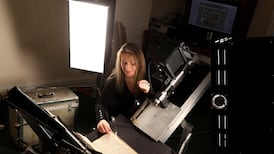The science behind 'Jurassic Park' once seemed far-fetched, to say the least, but DNA research has become so advanced that recovering genetic material from extinct animals is now a reality, writes Dick Ahlstrom
BIOLOGISTS NOW have a new place to search for interesting samples – in dried-up old museum displays. Greatly improved methods for digging out genetic scraps means that even long-extinct creatures can see their DNA come back to life.
The new approach has been dubbed “museomics”, a play on genomics, the study of genomes. It arises because researchers are getting much better at recovering DNA samples from old bones, hair follicles and dried-out tissue samples, all of which tend to feature in museum displays.
They are also working with improved high-speed, high-throughput equipment able to provide a detailed step-by-step sequence for any genetic material that is found.
The latest example is a partial genome for the Tasmanian Tiger, Thylacinus cynocephalus, an animal that went extinct in 1936.
An international team recovered both mitochondrial (inherited from the maternal line) and nuclear (from within the cell) DNA from hairs from a male Tasmanian Tiger brought to Washington DC's zoo in 1902 and a female that died in the London zoo in 1893. Details of their work are published this week in the journal Genome Research.
Coincidentally, our own Natural History Museum (NHM) holds the remains of no fewer than four Tasmanian tigers. “We are responsible for the deaths of four Tasmanian tigers,” says museum director, Nigel Monaghan. “We can prove at least one of these was shot at the request of the then museum director in 1917, which is now stuffed and sitting in the Natural History Museum,” he says.
Evidently, the then director RF Scharff felt the museum’s existing stuffed tiger looked a bit scruffy and decided a new one was needed. Knowing they were fast approaching extinction, he requested one be captured and killed before there were no more to be found.
Long-dead animals are featuring more and more in genome studies. Late last year, another international team delivered a large part of the woolly mammoth genome, an animal thought to have been hunted out of existence by our ancestors about 10,000 years ago. The mammoth work was made easier because the samples had been kept conveniently frozen in arctic permafrost during the intervening millennia.
The techniques have got so good, however, that even dried-out samples can now often be made to give up their secrets, according to Prof Dan Bradley, professor of population genetics at Trinity College. “A lot of interesting museum samples will yield interesting DNA,” he says.
Success in reconstituting old or ancient DNA depends on how it was stored, he says. Many samples, such as those pickled in formaldehyde or formalin (a mix of formaldehyde and water), would offer nothing as the chemical breaks up the DNA. Dried samples are often fine, however, because the DNA can still be recovered. DNA is also well preserved in tissue samples stored in alcohol, and happily the NHM has thousands of samples stored in pure alcohol. “The material with the National Museum in Dublin is great for DNA,” says University College Dublin biologist Dr Gareth Dyke.
In part, this is a reflection of how old the museum’s collection is, with its biological samples originally stored at a time when costly ethanol was used to preserve them. These materials were left untouched even as other collections, such as in London’s NHM, were “modernised” using lower-cost preservatives.
“If you compare our collection with the Darwin Centre collection , there is more you could use for ancient DNA,” says Dr Dyke.
The notion of reconstituting the DNA of long-dead organisms such as the dodo bird, mammoth or even dinosaurs, often triggers the related notion of resurrecting the animal, an idea brought to the cinema in the Jurassic Parkfilms. They described DNA being recovered from dinosaur blood extracted from mosquitoes that became trapped in ancient amber.
“That was good science fiction,” Prof Bradley suggests, but in fact it would be very difficult to get readable DNA from such an old source. “It depends on how old the DNA is and how hot it has been.” Heat tends to break down the DNA strands, making it unreadable.
The authors of the Tasmanian Tiger paper suggest that their work on the animal, not a tiger or even a cat, but a marsupial with many dog-like features, has opened the door on more museomic studies using what is described as a “treasure trove of museum specimens worldwide”. Researchers could do worse than starting their search among the alcohol-filled jars lining the shelves of the NHM.








